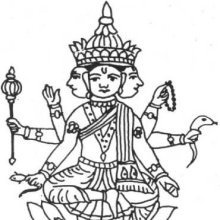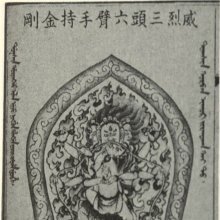Trimukha, Tri-mukha: 10 definitions
Introduction:
Trimukha means something in Hinduism, Sanskrit, Jainism, Prakrit. If you want to know the exact meaning, history, etymology or English translation of this term then check out the descriptions on this page. Add your comment or reference to a book if you want to contribute to this summary article.
Images (photo gallery)
In Hinduism
Purana and Itihasa (epic history)
Source: Wisdom Library: Skanda-puranaTrimukha (त्रिमुख, “three-mouths”) refers to one of the fifty-six vināyakas located at Kāśī (Vārāṇasī), and forms part of a sacred pilgrimage (yātrā), described in the Kāśīkhaṇḍa (Skanda-purāṇa 4.2.57). He is also known as Trimukhavināyaka, Trimukhagaṇeśa and Trimukhavighneśa. These fifty-six vināyakas are positioned at the eight cardinal points in seven concentric circles (8x7). They center around a deity named Ḍhuṇḍhirāja (or Ḍhuṇḍhi-vināyaka) positioned near the Viśvanātha temple, which lies at the heart of Kāśī, near the Gaṅges. This arrangement symbolises the interconnecting relationship of the macrocosmos, the mesocosmos and the microcosmos.
Trimukha is positioned in the South-Western corner of the third circle of the kāśī-maṇḍala. According to Rana Singh (source), his shrine is located at “Sigra Tila, Tripurantakeshvara, D 59/ 95”. Worshippers of Trimukha will benefit from his quality, which is defined as “the remover of fear”. His coordinates are: Lat. 25.18505, Lon. 82.59261 (or, 25°11'06.2"N, 82°35'33.4"E) (Google maps)
Trimukha, and the other vināyakas, are described in the Skandapurāṇa (the largest of the eighteen mahāpurāṇas). This book narrates the details and legends surrounding numerous holy pilgrimages (tīrtha-māhātmya) throughout India. It is composed of over 81,000 metrical verses with the core text dating from the before the 4th-century CE.

The Purana (पुराण, purāṇas) refers to Sanskrit literature preserving ancient India’s vast cultural history, including historical legends, religious ceremonies, various arts and sciences. The eighteen mahapuranas total over 400,000 shlokas (metrical couplets) and date to at least several centuries BCE.
In Jainism
General definition (in Jainism)
Source: archive.org: The Jaina IconographyTrimukha (त्रिमुख) is the name of the Yakṣa accompanying Sambhavanātha: the third of twenty-four Tīrthaṃkaras or Jinas, commonly depicted in Jaina iconography.—The Jaina literature relating to our subject provides the distinct clue to identify the image of Sambhavanātha. That clue is the symbol of horse (Turaya Skt. Turaga) connected with his representations. We are informed from the same literature of his Yakṣa being Trimukha and Yakṣiṇī being Duritārī Devī—other special marks of his images. The tree under which Sambhavanātha received the Kevala knowledge and of which the mention is made in the Jaina books is the Indian Śāla tree (Sharia robusta)—his bearer is called Satyavīrya.
Trimukha is Sambhavanātha’s attendant disciple. Texts of both the Śvetāmbaras and Digambaias are concordant in describing this Yakṣa as possessed of three faces, six arms andriding on a peacock. With respect to articles held in the hands, the books vary in some respects. The Śvetāmbara texts give him a mongoose, club, Abhaya-mudrā (for his right hands) and a citrus garland and rosary (for his right hands). Digambara text, on the contrary, gives the following attributes for his sixarms—a disc, sword, Śṛṇi (goad), staff, trident and dagger.
Source: archive.org: TrisastisalakapurusacaritraTrimukha (त्रिमुख) is the name of a Yakṣa (i.e., Śāsanadevatā) associated with Sambhava, according to chapter 3.1 [sambhava-jina-caritra] of Hemacandra’s 11th century Triṣaṣṭiśalākāpuruṣacaritra: an ancient Sanskrit epic poem narrating the history and legends of sixty-three illustrious persons in Jainism.
Accordingly: “There appeared in that congregation a Yakṣa-chief, named Trimukha, three-eyed, three-faced, dark, six-armed, with a peacock for a vehicle, carrying an ichneumon and a club in two right hands and bestowing fearlessness with a third, carrying a citron, wreath, and rosary in his left hands. In the same congregation there arose Duritāri, four-armed, fair, with a ram for a vehicle, adorned with right arms holding a rosary and granting a boon, and with left arms holding a serpent and bestowing fearlessness. Then the messenger-deities, Trimukha and Duritāri, were always near the Lord, like a body-guard”.

Jainism is an Indian religion of Dharma whose doctrine revolves around harmlessness (ahimsa) towards every living being. The two major branches (Digambara and Svetambara) of Jainism stimulate self-control (or, shramana, ‘self-reliance’) and spiritual development through a path of peace for the soul to progess to the ultimate goal.
Languages of India and abroad
Sanskrit dictionary
Source: DDSA: The practical Sanskrit-English dictionaryTrimukha (त्रिमुख).—an epithet of Buddha.
Derivable forms: trimukhaḥ (त्रिमुखः).
Trimukha is a Sanskrit compound consisting of the terms tri and mukha (मुख).
Source: Cologne Digital Sanskrit Dictionaries: Shabda-Sagara Sanskrit-English DictionaryTrimukha (त्रिमुख).—mfn.
(-khaḥ-khī-khaṃ) Having three faces. m.
(-khaḥ) A divine attendant upon a Jaina saint. f.
(-khā) A female deity of the Jaina sect. E. tri three, and mukha a face, three-faced, or tri three (worlds,) and mukha principal.
Source: Cologne Digital Sanskrit Dictionaries: Monier-Williams Sanskrit-English Dictionary1) Trimukha (त्रिमुख):—[=tri-mukha] [from tri] m. ‘three-faced’, the 3rd Arhat of the present Avasarpiṇī, [cf. Lexicographers, esp. such as amarasiṃha, halāyudha, hemacandra, etc.]
2) Trimukhā (त्रिमुखा):—[=tri-mukhā] [from tri-mukha > tri] f. Śākya-muni’s mother, [cf. Lexicographers, esp. such as amarasiṃha, halāyudha, hemacandra, etc.]
Source: Cologne Digital Sanskrit Dictionaries: Yates Sanskrit-English DictionaryTrimukha (त्रिमुख):—[tri-mukha] (khaḥ) 1. m. An attendant upon a Jaina sage. f. (khā) Female deity of that sect. a. Three-faced.
[Sanskrit to German]
Sanskrit, also spelled संस्कृतम् (saṃskṛtam), is an ancient language of India commonly seen as the grandmother of the Indo-European language family (even English!). Closely allied with Prakrit and Pali, Sanskrit is more exhaustive in both grammar and terms and has the most extensive collection of literature in the world, greatly surpassing its sister-languages Greek and Latin.
Kannada-English dictionary
Source: Alar: Kannada-English corpusTrimukha (ತ್ರಿಮುಖ):—[noun] (collectively) three divisions of something (as arithmetic, geometry and algebra of mathematics).
Kannada is a Dravidian language (as opposed to the Indo-European language family) mainly spoken in the southwestern region of India.
See also (Relevant definitions)
Starts with: Trimukhaganesha, Trimukhavighnesha, Trimukhavinayaka.
Ends with: Antrimukha, Gayatrimukha, Hantrimukha, Matrimukha, Strimukha, Tantrimukha.
Full-text: Trimukhaganesha, Trimukhavighnesha, Trimukhavinayaka, Duritari, Prajnapti, Vinayaka, Sambhavanatha.
Relevant text
Search found 8 books and stories containing Trimukha, Tri-mukha, Trimukhā, Tri-mukhā; (plurals include: Trimukhas, mukhas, Trimukhās, mukhās). You can also click to the full overview containing English textual excerpts. Below are direct links for the most relevant articles:
Trishashti Shalaka Purusha Caritra (by Helen M. Johnson)
Part 15: Sambhava’s messenger-deities (śāsanadevatās) < [Chapter I - Sambhavajinacaritra]
Jain Remains of Ancient Bengal (by Shubha Majumder)
Images of Tīrthaṅkara Saṃbhavanātha < [Chapter 6 - Iconographic Study of Jaina Sculptural Remains]
The twenty-four Tīrthaṅkaras and their Yakṣas and Yakṣiṇīs < [Chapter 6 - Iconographic Study of Jaina Sculptural Remains]
The Devi Bhagavata Purana (by Swami Vijñanananda)
Chapter 2 - On the description of the Śaktis, etc., of the syllables of Gāyatrī < [Book 12]
Chapter 16 - On the description of Sandhyā Upāsānā < [Book 11]
Jainism in Odisha (Orissa) (by Ashis Ranjan Sahoo)
Iconography of Jain Gods and Goddess < [Chapter 6]
The Skanda Purana (by G. V. Tagare)
Chapter 57 - Manifestation of Dhuṇḍhi Vināyaka and Fifty-six Vināyakas < [Section 2 - Uttarārdha]
Chapter 69 - The Assembly of Sixty-eight Holy Spots < [Section 2 - Uttarārdha]
A study of the philosophy of Jainism (by Deepa Baruah)
Chapter I.c - The lives of the Tīrthaṅkaras < [Chapter I - Introduction]
Related products

